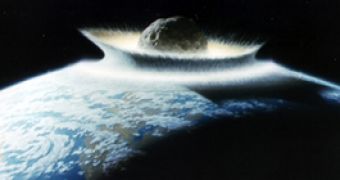Everything is fine on planet Earth. Well... not really. Not only that we commit suicide every day, by dumping enormous quantities of green house effect gases into our atmosphere, amongst other several problems, but we have no clear viable plan to handle the threat posed by the asteroid in the vicinity of our planet, that could intersect the orbit of Earth and cause havok.
A potential 22 million tons asteroid, the weight of some of the smallest ones, colliding with Earth could make the difference between life and death, on the planet we live on. The computer simulations correlated with the limited observations to keep track of the asteroids, are frequently used by astronomers to make forecasts of the potential threat posed by the asteroid Apophis, which will come in the close vicinity of our planet somewhere in the year 2029.
Though the chance that it will hit our planet are close to none, such objects can be easily influenced by weak gravitational fields to change their trajectory. So far, astronomers studying the asteroid's path say that they will have to wait at least 4 to 6 years before they can make a clear prediction regarding the second pass of the asteroid in 2036. The team of scientists studying the problem have reached this conclusion, after taking into consideration all the possible variables, such as the influence of solar wind, gravitational drag of other asteroids and the impact of human error.
Aphophis' calculated diameter is about between 210 to 330 meter and the uncertainties generated by measurement imprecision could potentially result in incorrect trajectories that could stop proactive efforts to study the alternative means to deflect it from its source.
The calculations made on the asteroid's trajectory in 2004 revealed a chance of 1 in 37 that it would collide with Earth in the year 2029, which was further corrected to a 1 in 45,000 chance, after measurements were made, based on the observations made with the Arecibo radio observatory, in Puerto Rico. Furthermore, it is estimated that it will probably pass at a distance of about 48 million kilometers from Earth in 2036, however, the pass in the vicinity of our planet in the year 2029 could greatly alter its trajectory that the asteroid will have after seven years.
The computer simulations, based on all the possible altering factors showed that the solar wind influence on a small asteroid could push it up to 30 million kilometers of its original calculated course, in the case of asteroid Aphophis.
Other sources of calculation errors could be inflicted by small uncertainties in the planet's mass, the Earth's imperfect shape and the interaction with other small asteroids.
Until the asteroid emerges from its hiding spot behind the Sun, astronomers won't be able to calculate with precision its course, before the year 2011 or maybe 2013. Observations regarding its shape, color or rotation on its axis, not just its position, should remove more than 97 percent of the uncertainties regarding its precise trajectory. Until then, however, scientists are studying the possibility of deflection.
Some of the solutions involve coating the asteroid with a reflective material, that can interact more actively with the radiation emitted by the Sun, which could push it of its course, as much as 6,400 kilometers, a distance equivalent to the radius of our planet.
Another scenario takes into consideration the possibility of adding weight in certain key places, which could alter the interaction with the Earth gravitational field, to push it onto another trajectory.

 14 DAY TRIAL //
14 DAY TRIAL //